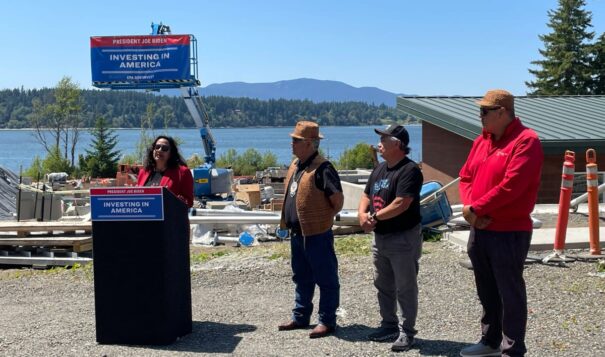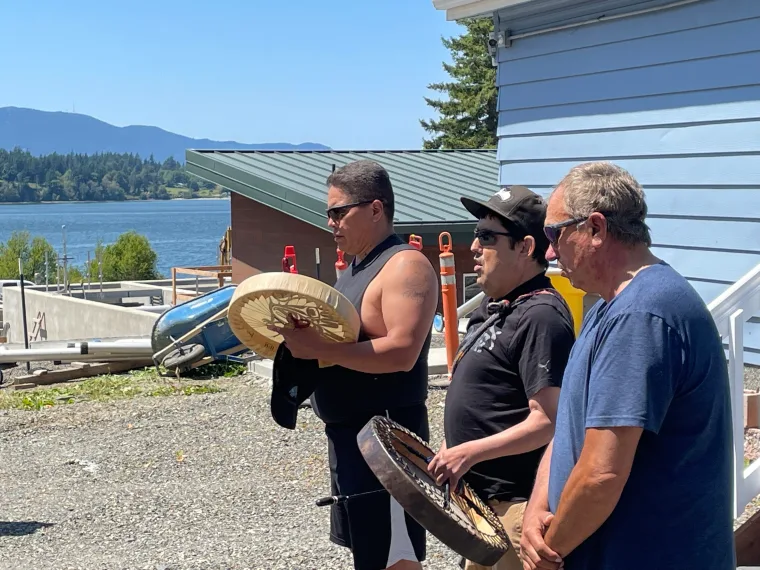News Based on facts, either observed and verified directly by the reporter, or reported and verified from knowledgeable sources.
‘We must take care of the water’
 EPA Assistant Administrator Radhika Fox announces new instrastructure funds on June 28, 2023, for Native water projects at the sit of a new $18 million Lummi Nation wastewater treatment plant now under construction in Washington state. She is joined by three Lummi Nation officials - Council member Henry Cagey, Treasurer Cliff Culture and Vice Chariman Terrenace Adams. "This brand new facility represents a shared commitment to cleaning up Puget Sound,” Casey Sixkiller, EPA Region 10 administrator, said. (Photo courtesy of Environmental Protection Agency)
EPA Assistant Administrator Radhika Fox announces new instrastructure funds on June 28, 2023, for Native water projects at the sit of a new $18 million Lummi Nation wastewater treatment plant now under construction in Washington state. She is joined by three Lummi Nation officials - Council member Henry Cagey, Treasurer Cliff Culture and Vice Chariman Terrenace Adams. "This brand new facility represents a shared commitment to cleaning up Puget Sound,” Casey Sixkiller, EPA Region 10 administrator, said. (Photo courtesy of Environmental Protection Agency)
Infrastructure law sets aside $278 million in federal funds for water projects in Native communities
Henry Cagey remembers using an outhouse into the 1970s and drawing water from a well or from the Nooksack River that flows through the Lummi Nation Reservation in northwest Washington state.
“We’d put milk buckets in the back of the truck, bring the water up from the community well and haul it home. That was our drinking water,” Cagey, a Lummi Nation council member, told ICT.
“People who lived by the river took the water right out of the river and we drank it. We’d wait for the sediment to settle and it was OK to drink.”
Until children started getting sick. Young noses filled with thick green mucus and there were infections associated with impetigo. The cause: contamination from agricultural runoff, Cagey said.
Contamination and a growing population on the reservation spurred development of water and wastewater treatment plants in the 1970s to serve the reservation’s 21 square miles, and construction is now underway on a new $18 million wastewater treatment plant that will discharge cleaner treated wastewater into the sea.
But Lummi’s past experiences are present-day reality for many Indigenous communities in the U.S. – Native households coast to coast are 19 times more likely than White households to lack indoor plumbing, according to a coalition of Colorado River-dependent tribal nations.
“Over the last century, the U.S. federal government’s investment in modern water and sanitation systems largely bypassed Native communities,” the coalition reported.
The federal government is now trying to catch up.

The 2021 Bipartisan Infrastructure Law – a 10-year, $1 trillion plan to rebuild America’s bridges, rails and roads, and expand access to clean drinking water and high-speed internet – will make $278 million available in 2023-2024 for contamination cleanup and construction of water and wastewater infrastructure in Native communities across Indian Country. Much of the funding is being made available through grant programs.
Officials with the Environmental Protection Agency visited the site of the Lummi Nation’s new wastewater treatment plant on June 28 to announce the availability of the 2023-2024 funding.
Lummi’s wastewater plant project received $16 million in an earlier round of infrastructure funding through the Clean Water State Revolving Fund, a federal-state partnership between EPA and the Washington state Department of Ecology. Officials touted the project as an example of what they hope can be accomplished with the 2023-2024 funds made available by the Bipartisan Infrastructure Law.
Casey Sixkiller, Cherokee, the EPA regional director in Alaska, Idaho, Oregon and Washington, said the $278 million is the largest single-year investment ever in water and wastewater projects in Indian Country.
“It’s a big day. This is going to be funding water infrastructure for years to come,” Sixkiller said.
Significant though it may be, it’s not known how big a dent the funding will make in meeting water and wastewater needs in Indian Country. The U.S. has a government-to-government relationship with 574 tribal nations, and 271 of them are in Sixkiller’s Region 10.
Several steps forward, one step back
Ancestral lands had been abused and exploited by 1971 when Alaska Native regional corporations and villages got the lands back through the Alaska Native Claims Settlement Act.
Those lands had been used by government and industry for years for fuel storage, mining, power generation, waste handling and other activities. Those uses left behind arsenic, asbestos, lead, mercury, pesticides, PCBs, and petroleum products — contaminants that continue to pose health risks, negatively impact subsistence resources and hamper economic activity.
Similar uses had similar effects on Native lands in the Lower 48 as well.
Some 39 percent of water wells on the Crow Reservation in Montana are unsafe for long-term water consumption because of metals and nitrates, according to reports on file at the National Institutes of Health. Nitrates are used in the manufacture of explosives, fertilizers and metals.

Uranium content in numerous wells on the Navajo Nation exceeds drinking water standards. Much of the contamination is the result of mining that took place on Navajo lands from 1944 to 1986, according to the Navajo Nation Environmental Protection Agency. An estimated 30 percent of the Navajo Nation population does not have access to clean reliable drinking water.
The Navajo Nation Department of Water Resources manages or is developing several water supply systems to improve access to water on the 27,000-square-mile reservation. Navajo Nation and the City of Gallup, New Mexico, are teaming up on a pipeline that will carry water from the San Juan River to 40 Navajo communities in New Mexico and Arizona, the City of Gallup, and the southern part of the Jicarilla Apache Nation. Other pipelines will carry water from Colorado River-fed Lake Powell and from Farmington to Shiprock.
In addition, the nonprofit organization DigDeep is installing indoor plumbing and 1,200-gallon underground water tanks — replenished regularly by water trucks — in homes in isolated areas of the Navajo Nation.
Then, amid several big steps forward, there was a big step back. Competing interests and drought have made the supply of Colorado River water precarious. And despite treaty language indicating otherwise, the U.S. Supreme Court ruled 5-4 on June 22 that the United States has no “affirmative duty” to guarantee the Navajo Nation access to water from the Colorado River – a decision that could force Navajo Nation to spend money exploring and developing other water sources to make up for the loss.
In his dissent, Supreme Court Associate Justice Neil Gorsuch wrote that the 1868 Treaty of Bosque Redondo promised adequate resources to the Navajo people who returned to their homelands after The Long Walk. Gorsuch also cited a 1908 Supreme Court decision that named the federal government a “fiduciary” of reservation resources.
Where the money comes from
The $278 million for water and wastewater infrastructure projects is being made available through several grant programs. According to information provided by EPA, the grants include:
- Drinking Water Infrastructure: $130.3 million
- Clean Water Indian Set-Aside: $64 million
- Alaska Rural and Native Villages grant program: $39.6 million
- Emerging Contaminants in Small or Disadvantaged Communities: $38.6 million
- Small, Underserved, and Disadvantaged Communities Tribal Grant Program: $5.6 million.
The infrastructure law funding in 2023-2024 will “advance public health protections,” the EPA reported, “by improving compliance with existing water regulations, identifying and replacing lead service lines, and addressing harmful emerging contaminants in drinking water and wastewater, such as per- and polyfluorinated substances (PFAs).”
Nearly $60 million of the $278 million will be spent in Alaska, funding construction of drinking water and wastewater facilities and cleaning up contaminated sites. Participating federal agencies include the U.S. Army Corps of Engineers, U.S. Bureau of Land Management and the U.S. Department of Justice.
Sixkiller said the EPA will lead federal efforts “to expedite cleanup of legacy contamination on lands conveyed to tribal communities through the [Alaska Native Claims Settlement Act]. This has been a long time coming and we’re finally able to fund work to reduce the risks and impacts to Native communities.”
Sixkiller said the State of Alaska, Alaska Native Tribal Health Consortium and Alaska Native Village Corporation Association will help “coordinate our efforts to inventory, verify, assess and clean up the sites, starting this year.”
Two officials said on June 28 that the funding — and the infrastructure work — are long overdue.
“For too long, tribes have struggled without access to basic water services — impacting their health and economic well-being,” EPA Assistant Administrator Radhika Fox said in an announcement of the funding on June 28.
“Today’s funding announcement is a generational investment that moves us closer to achieving a future where all tribes have access to safe drinking water and wastewater services.”
U.S. Sen. Lisa Murkowski, R-Alaska, said in the same announcement that it is “long past time that the federal government take steps to address the environmental injustice committed when contaminated lands were conveyed to Alaska Native Corporations as settlement for their land claims under ANCSA.”
Taking care of the water
The Lummi Nation’s new wastewater treatment plant will positively affect water quality and habitat for salmon and forage fish. One Lummi Nation official said he hopes the Bipartisan Infrastructure Law funding for 2023-2024 will spur similar projects.
Environmental conditions and wastewater treatment technology have changed greatly since the current treatment plant went online, Cagey said. Salmon, orcas and other marine species that call the Salish Sea home are struggling to survive in waters taxed by warming temperatures, increased shipping traffic and pollution from industrial uses that dot the waterfront from Seattle to Bellingham.
The new treatment plant will make cleaner the treated wastewater that is discharged into Hale Passage, between the Lummi Reservation and Lummi Island — the latter is not part of the reservation but is within the Lummi Nation’s historical territory. This in turn will protect water quality in shellfish-producing areas used for commercial and tribal harvests, as well as habitat for salmon, rockfish and orcas, supporters said.
“This brand new facility represents a shared commitment to cleaning up Puget Sound,” Sixkiller said after a tour of the wastewater treatment plant site in June. “It will ensure as water is treated and released, it’s clean and safe for salmon, orca, and other critters that call Puget Sound home.”
Lummi Nation Vice Chairman Terrence Adams called the Bipartisan Infrastructure Law funding “a great opportunity for all tribal nations that are looking for assistance with tribal water systems.”
“Tribal people have an important relationship with the water,” Adams said, “and we believe that it is our inherent responsibility to take care of the water as it cares for us.”
